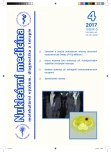Detection of splenosis on somatostatin receptor scintigraphy – a case report
Authors:
Iva Štufková 1; Lukáš Fil 1; Otto Lang 1,2
Authors‘ workplace:
Oddělení nukleární medicíny, Oblastní nemocnice Příbram, a. s., Příbram, ČR
1; Klinika nukleární medicíny, 3. LF UK a FNKV, Praha 10, ČR
2
Published in:
NuklMed 2017;6:70-73
Category:
Casuistry
Overview
Aim:
Presentation of an atypical pattern on somatostatin receptor scintigraphy with a risk of false positive interpretation.
Case report:
42y-old patient was sent to our department for somatostatin receptor scintigraphy due to a suspicion to neuroendocrine tumor. He experienced a long lasting chronic diarrhea with abdominal pain. He underwent several abdominal surgeries, he had an accident with the liver and spleen laceration with a following splenectomy 13 years ago. Irregularly increased accumulation of a radiopharmaceutical (111In-pentetreotide) in the left mesogastrium anteriorly except of physiological accumulation in the liver and kidneys was detected on somatostatin receptor scintigraphy. Small nodules were visible on SPECT/CT images at this location. This patient was evaluated in our department with denaturated erythrocytes due to multiple nodules detected on CT image in the left mesogastrium two months ago; splenic tissue was confirmed in these nodules. Comparing these images with somatostatin receptor scintigraphy, we concluded that atypical location of somatostatin receptors at the left mesogastrium is caused by accumulation of radiopharmaceutical in the splenic tissue in patient after splenectomy with autotransplantation.
Conclusion:
We present a case of a detection of a splenosis on somatostatin receptor scintigraphy performed in patient evaluated for a suspicion of neuroendocrine tumor. Our case report alerts to a risk of false positive interpretation and points out the necessity of a careful history including a record of splenosis into the medical documentation in a patient with a splenic injury in the past. This can spare such patient unnecessary and potentially risk future invasive examination.
Key words:
splenectomy, splenosis, denaturated erythrocytes scintigraphy, somatostatin receptor scintigraphy, 111In-pentetreotide
Sources
1. Ksiadzina D. A case report of Abdominal Splenosis – a Practical Mini-Review for a Gastroenterologist. J Gastrointestin Liver Dis 2011;20:321-324
2. Ksiadzyna D, Peña AS. Abdominal splenosis. Rev Esp Enferm Dig 2011;103:421-426
3. Baden LR. Splenosis Mimicking Cancer. N Engl J Med 2016;374:20
4. Williams K, Simpson G. Thoracic splenosis: diagnosis without invasive investigations. Respirology Case Reports 2017;5:e00274, doi: 10.1002/rcr2.274
5. Sikov WM, Schiffman F, Weaver M et al. Splenosis presenting as occult gastrointestinal bleeding. Am J Hematol 2000;65:56-61
6. Vento JA, Peng F, Spencer RP et al. Massive and widely distributed splenosis. Clin Nucl Med 1999;24:845-846
7. Miller JS, Nunez A, Espada R. Thoracic splenosis 25 years after gunshot wound to the abdomen. J Trauma 2001;50:149-150
8. Yeh CJ, Chuang WY, Kuo TT. Case report: unusual subcutaneous splenosis occurring in a gunshot wound scar: pathology and immunohistochemical identification. Pathol Int 2006;56:336-339
9. Rickert CH, Maasjosthusmann U, Probst-Cousin S et al. A unique case of cerebral spleen. Am J Surg Pathol 1998;22:894-896
10. Losanoff JE, Jones JW. Splenosis after laparoscopic splenectomy. Surg Endosc 2001;15:1497
11. Papakonstantinou E, Kalles V, Papapanagiotou I et al. Subcutaneous Splenosis of the Abdominal Wall: Report of a Case and Review of the Literature. Case Reports in Surgery 2013, Article ID 454321, 5 pages (http://dx.doi.org/10.1155/2013/454321)
12. Hagan I, Hopkins R, Lyburn I. Superior demonstration of splenosis by heatdenatured Tc-99m red blood cell scintigraphy compared with Tc-99m sulfur colloid scintigraphy. Clin Nucl Med 2006;31:463–466
13. Krouská L, Černá L, Maříková I et al. Detekce viability regenerátů implantovaných autologních částí sleziny po traumatu. Nukl Med 2017;6(S1):11(A)
14. Demirci E, Simsek DH, Kabasakal L et al. Abdominal Splenosis Mimicking Peritoneal Metastasis in Prostate-Specific Membrane Antigen PET/CT, Confirmed With Selective Spleen SPECT/CT. Clin Nucl Med 2017;42: e504–e505
15. Derlin T, Wester HJ, Bengel FM et al. Visualization of Posttraumatic Splenosis on Chemokine Receptor CXCR4-Targeted PET/CT. Clin Nucl Med 2017;42: e317–e318
16. Lebtahi R, Cadiot G, Marmuse JP et al. False-Positive Somatostatin Receptor Scintigraphy Due to an Accesory Spleen. J Nucl Med 1997;38:1979-1981
17. Salihoglu YS, Elri T, Erdemir RU et al. (111)In-pentetreotide uptake in accessory spleen: A potential pitfall in somatostatin receptor scintigraphy. Indian J Nucl Med 2016;31:161-162
18. Reubi JC., What is a False-Positive Somatostatin Receptor Scintigraphy? J Nucl Med 1998;39:2193-2194.
Labels
Nuclear medicine Radiodiagnostics RadiotherapyArticle was published in
Nuclear Medicine

2017 Issue 4
Most read in this issue
- Detection of deep venous thrombosis on labeled leukocytes scan
- Fluidothorax on lung perfusion scintigraphy
- An implementation and using of a simple radiochemical purity assessment method of [99mTc]-etifenin
- Detection of splenosis on somatostatin receptor scintigraphy – a case report
